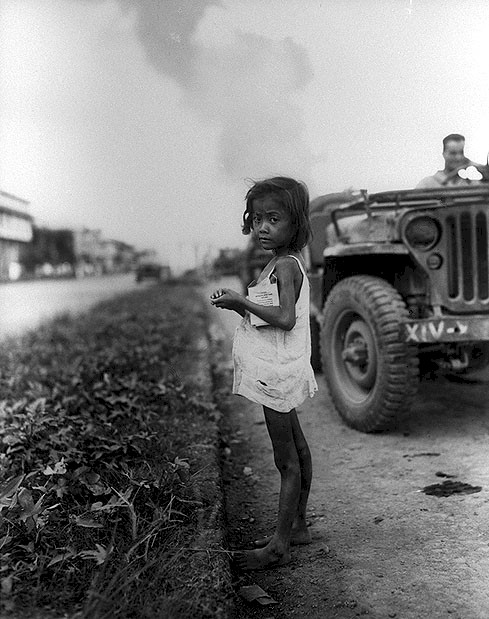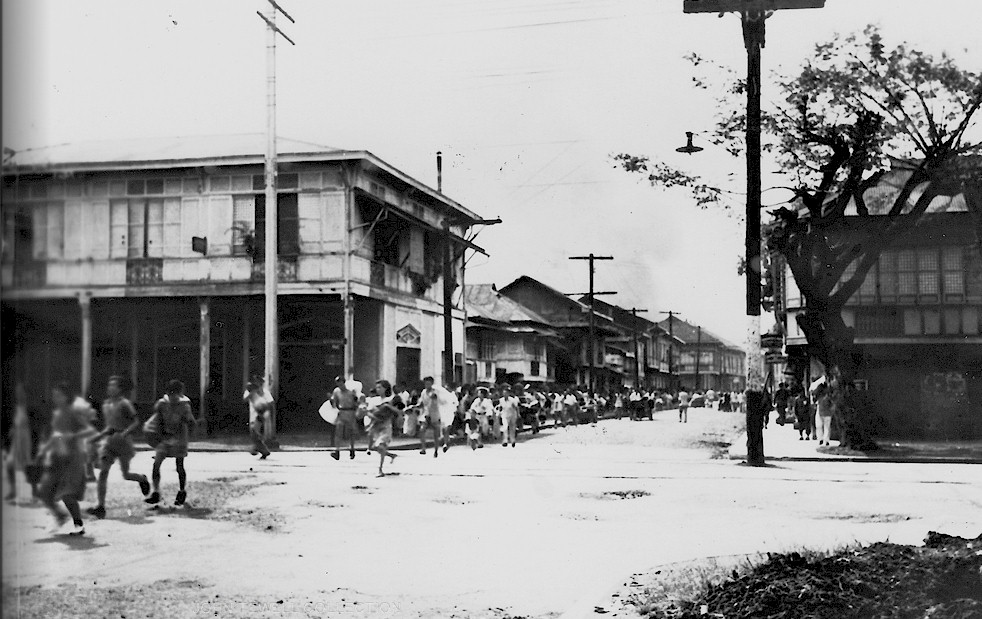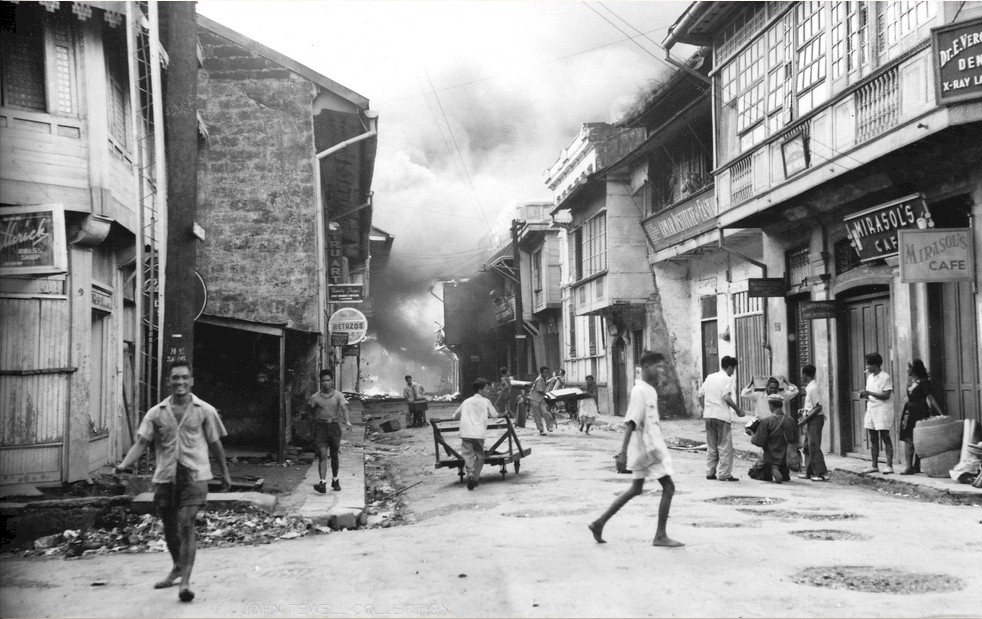THE BATTLE OF
MANILA
- MYTH AND FACT
by
Peter C. Parsons
I have been one of the lucky few in American History who
has both filed War Correspondent's reports from an active war zone, and
who has owned a newspaper. It was only small , but owning it has
earned me the right to hold a deep and abiding contempt for those of the
revisionist liberal media hive who prefer to publish falsehoods than
truths because they believe themselves the appointed filters of what
constitutes history and what is mere fact filler. They have paved a road
to hell along which good intentions trump outcomes even when those
intentions lead to catastrophe. To them, the evil of MacArthur is
the counterpoint of Yamashita, an honorable man of good intent who should
not be sanctioned by history irrespective of the consequences when he
turned his back upon 100,000 Manileños.
This is an edited text of
paper presented at a Battle of Manila conference at the Ortigas WWII
Library on 7 February, 2008 and deals with the truths which my colleague
Lucky Guillermo and I embedded in our film documentary, Manila 1945 - The
Forgotten Atrocities.
___________________________________
 I have stated from the outset, when I
was first invited to present a paper here, that I am not an historian. I
worked 35 years in California as a newspaper person and printer. I have
retired from that to a life of reading and writing. My first writing was
fiction--short stories and novels—still my preference if I were not so
addicted to history. Some would like to suggest I am still writing
fiction. I have stated from the outset, when I
was first invited to present a paper here, that I am not an historian. I
worked 35 years in California as a newspaper person and printer. I have
retired from that to a life of reading and writing. My first writing was
fiction--short stories and novels—still my preference if I were not so
addicted to history. Some would like to suggest I am still writing
fiction.
But the demands of history are very
interesting. I do not feel that the restraints of truth are a terrible
burden to labor under.
.
But I have also discovered that truth is as elusive as water in your hand,
it wiggles like an eel. My former partner in videos, Morgan Cavett
remarked once, after we had two totally contradictory interviews, one with
guerrilla Edwin Ramsey, and one with Luis Taruc. Each ended up calling the
other a liar (Ramsey added "sonofabitch")( and Taruc added a “disrespectful
womanizer”)—Morgan, who was running the camera, said, “Well, that seems to
be how history is constructed; our job is just to record what the
participants say.”
Trying to find out the truth about my
father’s life and work here in the Philippines, for instance, was a
wonderful training ground. So many things written about him, and even by
him, were untrue: his US Navy biography gives his birth year as 1902.
Wrong. No one knew until the late 80’s, just before he died, that he was
born in 1900. The only document where he stated his correct birth date was
his marriage certificate; this was also the only document wherein my mom’s
age was entered incorrectly
(probably to make it seem like she was eighteen instead of her real age:
16).
He included in his resume that he had two
years of college at the University of Tennessee. And two more years at the
University of the Philippines. Wrong again.
A search of records in Tennessee did not
reveal him as a student at any of their campuses.
And as for UP, I found a letter from the
bursar at UP indicating a partial refund of my father’s tuition – at his
request – as he was dropping his classes there.[1]
The trail my father left behind was an
intellectual boot camp, and led me to the National Archives in both Manila
and in the United States, as well as to many military repositories of war
documents. And, of course, to many people whom we interviewed because they
either knew or had worked with Commander Chick Parsons, or had good
stories to tell about him. While we did this, we inadvertently picked up
hundreds of hours of wonderful – and now-invaluable oral history – as
about 90% of these interviewees have died.
I know there are several of you in here tonight and I can only thank God
that he has spared you![2]
Now, more to the point of our documentary,
Manila 1945, The Forgotten
Atrocities.
I
will say that I stumbled across these atrocious findings while searching
for my father. I acquired nearly all the still pictures as well as the
military footage (both American and Japanese) at College Park, Maryland,
as well as from local historians such as Ricardo (Rico) Jose and Edgar
Krohn
and,
Ernie
de Pedro at Santo Tomas, and the material to be found at the Lopez, Ayala
and Intramuros locations. Videographer Lucky Guillermo, my partner in this
film, has a surprising collection of WWII footage.
I
found that the state of the war crimes papers in Manila was very
poor with bundles of papers being tied together with
a twine that
was cutting into the deteriorating bundles. The photos seem to have
disappeared long ago,
and the woman whom I asked about them got very surly and uncooperative.
This was probably an appropriate reaction to my natural charm.
In Maryland I learned to use white cotton gloves to
handle any archival photographic material.
All pictures copied were imprinted with
the National Archives
permiso
and logo – [“Reproduced at the National Archives”]; all textual material
was similarly marked as OK. You could stay there from 9:00 a.m. to about
9:00 p.m. And we did. We were carefully inspected as we left.
I wanted to live there, I mean inside there.

Filipinos learned to move fast – an art that saved many lives during the
unpredictable events of the battle.
There are two very basic books on the Battle of Manila, Bibles sort
of. One is Alfonso Aluit’s
By Sword and Fire
published in 1994; the other is a US Army publication of 1963 by Robert
Ross Smith called Triumph
in the Philippines. There are a
lot more, including one I refer to herein published to commemorate the 50th
Anniversary of the catastrophe. More on this one later. But there is
little that can be added to what is written in the first two. The many
memoirs and personal stories lend depth and color and horror, and it is
recommended to any student or researcher to read them all. There was also
an early equivalent of Aluit’s book in Spanish called
El
Terror Amarillo en Filipinas, by
Antonio Perez de Olaguer which was published in Spain in 1947 while the
wounds were still open. An abridged version of this--in English--with a
new title, a bit more politically acceptable these days,
Terror
in Manila, February 1945. This
was undertaken by the Memorare Manila 1945 Foundation in 2005.
These three books form a deeply and
broadly researched platform from which to dive into the subject. I did not
know of any of these in the mid-90s. The memories of those times were so
dire that many memoirists, like Lourdes Montinola and Elena Lizarraga only
dared face their pain after the passage of 50 and more years. [I am
batting 500 here; Elena died shortly after our interview, but I am happy
to say that Lourdes marches on strongly—though she is not here tonight
because she is seeing a doctor.]
When I came across the War Crimes
Investigation report [3]
compiled during February, March, and April of 1945, I
nearly swooned. There were dozens of people there that I knew or had
known both before and after the war. I never knew that my father’s
office manager in Hong Kong had lived on Calle Estrada and that his
father, Eustacio Barros, had been wantonly killed by a Japanese
soldier when he left his burning house. I read about the massacre at
the Perez Rubio home on Vito Cruz, complete with my own father’s
testimony. And the simultaneous massacre on the other side of the
shared-wall at the home of Lianteng Sy (on Balagtas St.)—whose only
surviving family member is a good friend of mine. On and on.
I also discovered that the massacre
and rape of Manila was not owned by a Spanish and mestizo elite.
Here
were the names and pictures of Filipino after Filipino, plus Irish,
Russians, Germans, Chinese, Spanish, Americans, Jews (of whatever
nationality) all being killed indiscriminately. But at heart, it was a
Filipino event,
a Filipino massacre: a nearly totally forgotten occurrence. And this
became what I wanted to portray in our documentary. But at that time
my main effort was to discover material about the Philippine
resistance movement, the guerrllas, and wherever possible about my
father in particular.
Finally, there was, on pages 33-35,
the blazing testimony of Nicanor Roxas, a secretary to President
Laurel in the provisional government, telling what he had been told by
Pio Duran, the second supreme head of the MAKAPILI, that the Japanese
had planned to destroy Manila and the civilian population. He said
that the Japanese had located heavy artillery and aimed it at Manila
from positions surrounding the city.[4]
In the documentary film by David B. Griffin it is said that Yamashita
asked for instructions from Tokyo and the destruction of Manila and
its population was his answer. I
had not come across this brief documentary before doing my own, and I
am surprised and gratified that our conclusions are nearly identical.
At the MacArthur Memorial in Norfolk,
Virginia, we read guerrilla reports being radioed to MacArthur’s GHQ
outlining the build-up of defenses within the city of Manila by the
Japanese. These reports[5]
were from people like Captain Bartolomeo Cabangbang, who came in by
submarine with my father on the east coast of Luzon, and Lt. Edwin
Ramsey, leader of the East Central Luzon Guerrillas Area.
This
defensive/offensive build-up started immediately after the departure
of President Laurel and others of his cabinet to Baguio. The
communiqués are replete with locations of pillboxes, ammunition dumps,
fortifications, troops, and information about buildings and bridges
being prepared for demolition.
This
began while Yamashita was still in Manila.[6]
The fortification was going on during December and January.There
is even one astonishing recommendation from Cabangbang in which he
recommends to MacArthur that US planes bomb a certain location on the
Escolta where Japanese had stored weapons and explosives.

With a raging fire a block away, these people seem remarkably
unconcerned.
|


